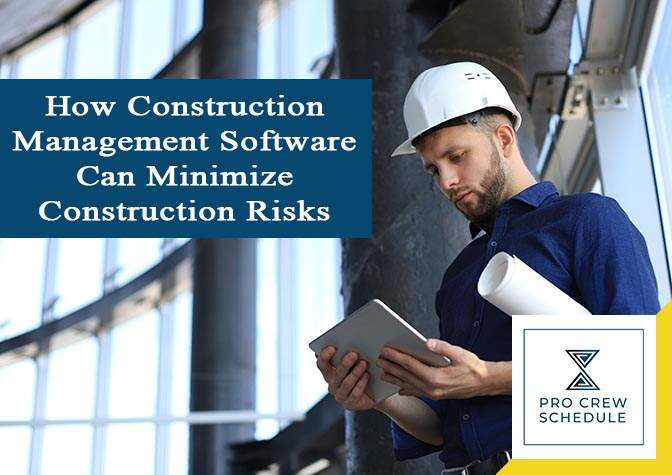Do you know that there are around 107 risks you should consider when managing construction projects? That is about true, according to The Construction Industry Institute. Before you start panicking about some of the construction risks you’ve heard of for the first time, let’s take a step back. While extensive, this long list isn’t quite actionable because it contains factors you can’t control, such as acts of god and force majeure.
In most construction projects, internal resources are stretched to their limit, and project managers struggle to deliver the necessary control and performance assessment continually. However, a solid risk management strategy is vital to the projects’ security and the whole company. So the question is, how do you know where to invest your time and resources in order to curtail the significant construction risks and control what feels uncontrollable?
Given how hard it is to control risk, construction project management software is one fitting solution that can help you to manage multiple risks if implemented throughout the whole project duration. With the right team and program, creating a risk-based operational program can help you efficiently manage the entire project lifecycle. Here are the top construction risks that you can control using the right project management software to help you streamline your risk assessment.
3 Primary Types of Construction Risks
To fully understand how construction software can help mitigate a project’s risk, it is essential to know the major types of construction risks first. Typically, risks on construction job sites fall under one of the three categories: design, finance, and schedule.
1. Design
Design management during construction operations is a growing risk that must be deliberately managed. When the time is in constraints, a project team may agree to accept an unfinished design that is only “good enough” to build in order to start the project according to the planned schedule. The project team will just eventually back manage this risk by working to get the design aligned during construction. This scenario is prevalent in today’s industry, where the speed to start construction is an immediate request from the owners. Frequently, construction risks related to design can be avoided starting from the pre-construction planning phase when the owner, together with the designers and contractors, can align more closely.
2. Finance
Even though exceeding budget on projects has become an industry-norm, finance issues are usually a result of bad coordination and planning. We all know how megastructures projects can easily go millions and millions over the intended budget. However, if a project experiences the slightest budget excess of even a small percentage, this could dramatically affect managing the company’s future liquidity.
3. Schedule
In construction, time can indeed be considered as money. Undeniably, poor scheduling and construction crew management can have an enormous impact on a budget. Just a single mistake in the contracts and even the slightest miscommunication could set your schedule back by days, or even years due to needs like rework, rectifying of punch list items, and not to mention generating high-cost overruns. Even the smallest delay can produce a project-wide impact that can change the original project schedule outright. This means that project teams must re-evaluate their master game plan, which will lead to fewer mistakes and delays.
Why It Is Important to Manage Construction Risks
Recognizing the most common risks in the major areas of construction operations can help understand why it’s important to manage them throughout the project lifecycle closely. Without proper construction risk assessment and control, the project team will find themselves in a position where they only rely on the people who manage these risks to update and report on them, creating a cycle of rework and schedule delays.
But here is the good news: through construction project management software, the project managers can streamline risk control and provide advanced project visibility for stakeholder by allowing the following:
– Real-time access to documents, reports, and other data
– More quality work and integrity among team players
– Improved collaboration
To help you further understand how software can enhance your risk management strategy, we outlined the top construction risks with the most significant potential to impact project design, cost, and schedule performance. With these main points in mind, you can begin allocating your resources more cost-effectively and efficiently to manage the highest priority risk better early in a construction project lifecycle.
4 Possible Risks in Construction
1. Labor Shortage
Even though demand for construction projects remains very high, finding the right people to bring your project to completion is a significant dilemma for today’s construction professionals.
At this time, the labor shortage is one of the most pressing risks to construction projects. The truth is, even with the best pre-construction design and planning in the world, if you don’t have enough staff to execute the work needed, your project is subject to significant delays from the very beginning. Therefore, technology can remedy this long time dilemma in the construction industry?
Construction management technology can help you attract and retain the best construction employees. Additionally, it can also be used to improve the productivity of the workers who are already on your payroll. This way, you can justify your budget and costs and note which subcontractors should you tap again for your next projects based on their productivity. With the right subcontractor scheduling software, you can actually quantify your team’s productivity by a measure of time, helping to make more efficient hiring decisions and reduce risks for your next projects.
2. Coordination Obstacles
Miscommunication in construction can naturally occur even though the whole project team speaks just one language. From misalignments in documents and contracts to neglecting to regulate the project’s movement closely, there are countless ways in which communication can push back costs and schedules and risk the project’s overall success.
Software can help alleviate risks in construction brought by miscommunication by simply aligning everyone to ensure that each team member is on the same page. When plans, RFIs, markups, and more can be accessed in one cloud-based system, real-time updates can be pushed effortlessly for the whole project team. As a result, the team now has the right and updated data to make informed decisions, significantly reducing the risk of going over the intended budget and disrupting the timeline.
3. Poor Documentation
All construction projects, especially the megaprojects, require hundreds and thousands of documents, which can be a headache to manage using a traditional paper-based system. Shocking enough, 40% of the US construction companies are still using paper plans for their projects! From starting the pre-construction process, moving on to the construction phase and operations, to completing a project turnover and closeout, your team will continuously need to access documents again and again. Trying to look for documents manually can significantly drain your time, making it more difficult to update it and put information. As a result, this kind of analog system will risk potential schedule delays for your project.
If you are among the 40% who are still sticking to the old construction documentation methods, now is the best time to move to a cloud-based solution to streamline your document control and reduce risks brought by poor handling of paper works. Imagine how much efficient your projects and life will be if you can access thousands of project documents with a tap of your finger, wherever you are. By making all your construction documents accessible on mobile software and allowing your team to access it when they need it the most, you take coordination on the job site to the next level, all while providing a less risk-averse work environment.
To learn more on how you can improve your documentation process for your project, read our article on “Construction Document Control: 9 Tips to Streamline Your Process.”
4. Inconsistent Reporting and Errors
If your current manual report system leaves room for error and delays, you risk your project budget and timeline. Not being able to edit your reports anywhere and in real-time can delay critical information for hours, or even days, which also risks recording outdated and misremembered information. With the best construction management software that features options for timely field reporting, you can personally check if an issue has been addressed and reported, and if not, submit your report instantly to ensure that timelines are intact.
One more benefit of submitting reports through mobile software is the flexibility to automate reports, minimizing the frequent risk of human error, which is inevitable. Furthermore, there an excellent software solution that enables you to go deep with your reports. A good project management software will let you include photos and videos to be added as an extra level to enhance the way you share information with your team.
Ready to explore the future of construction management software? Pro Crew Schedule is one of the front runners today in the industry. Don’t get left behind.







